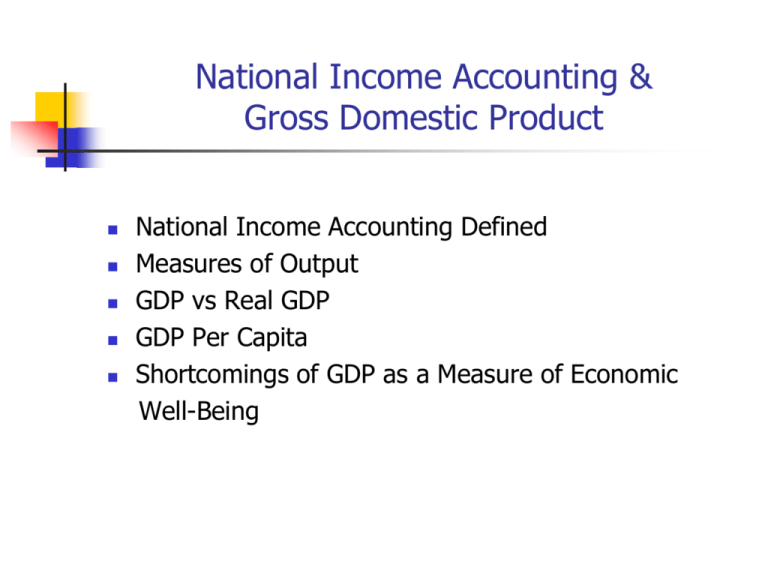
National Income Accounting &
Gross Domestic Product
National Income Accounting Defined
Measures of Output
GDP vs Real GDP
GDP Per Capita
Shortcomings of GDP as a Measure of Economic
Well-Being
Measures of Output (Production)
National Income Accounting refers to the
measurement of aggregate economic activity,
particularly national income and its components.
Aggregate = Total or Gross
Measures of Output (Production)
Gross Domestic Product is the total dollar value of
final output produced within a nations borders in a
given time period at current market prices
Gross Domestic Product is also referred to as
•
•
Nominal Gross Domestic Product
Current Gross Domestic Product
Measuring Gross Domestic Product
The Expenditures Approach
•
The Flow of Income Approach
•
C + I + G + (Xn) = GDP
Households supply business with the factors of production in
return for payment in the form of wages, profits, rent, and
interest
The Value Added Approach
•
Adds the increase in value at each stage of the production
and distribution process
How GDP Is Measured?
Income (wages, salary, rent, interest, profits)
Flow of Income
Approach
Value of what is
produced
Same As
Firms
Expenditures
Approach
Households
Value of what is
spent
Expenditures by Consumers, Investors, Government, and Net Exports
(GDP = C + I + G + Xn )
Copyright 2002 by The McGraw-Hill Companies, Inc. All rights reserved.
9-10
The Flow of Income Approach
GDP (Gross Domestic Product)
- Depreciation
Net Domestic Product
- Indirect business taxes and subsidies
Domestic Income (DI) = National Income = (W + R + I + P)
- Earnings not received
+ Receipts not earned
Personal Income (PI)
- Personal Taxes
Disposable Personal Income (DPI)
Value Added in Various Stages of
Production
Stages of
Production
Value of
Transactions
Value Added
1. Farmer grows
wheat, sells it to miller
$0.12/lb
$0.12/lb
2. Miller grinds to flour,
sells to baker
$0.28/lb
$0.16/lb
3. Baker bakes bagel,
sells it to retailer
$0.60/lb
$0.32/lb
4. Bagel store sells
bagel to consumer
$0.75/lb
$0.15/lb
$1.75/lb
$0.75/lb
Total
Two Things to Avoid when Compiling
GDP
Multiple counting
Only expenditures on final products – what
consumers, businesses, and government
units buy for their own use belong in GDP
Intermediate goods are not counted
Used goods are not counted
Transfer payments
Transfer payments are not payments for
currently produced goods and services
When they are spent for final goods and services they
will go into GDP as consumer spending
Financial transactions don’t go into GDP
Copyright 2002 by The McGraw-Hill Companies, Inc. All rights reserved.
9-24
GDP vs Real GDP
Removing the effect of Inflation
Suppose we invited the same friends to a birthday
party each year for four years and purchased one
giant pizza each year.
We notice that although the giant size pizza doesn’t
change from year to year, it costs $1 more each
year.
The pie didn’t change, but the dollar value (price) of
the pie did
If we want to compare GDP from year to year, we
need to get rid of the inflation (price) effect!
Computing Real GDP
Nominal GDP (in
billions)
2004
Qtr 2, 2005
$11,734
$12,378
Change in Nominal
GDP
$644
Change in Price
Level, 2004 to 2005
1.5%
Real GDP in 2004
dollars
Change in Real GDP
$11,734
$12,195
$461
Computing Real GDP
The general formula for computing real GDP is:
Real GDP in year t = Nominal GDP in year t
Price Index
Real GDP in 2nd Qtr, 2005 = $12,378 = $12,195
1.015
GDP & the “GDP Deflator”
To correct Nominal GDP for price increases from one
year to the next, we must calculate real GDP using a
Price Index.
For GDP price adjustments, this price index is called
the GDP Deflator and is calculated quarterly by the
Department of Commerce.
A price index is an index number that shows how the
average prices of goods change over time. Based on
percentage change from a “base year”
GDP and Real GDP(in 1992Dollars), 1960-2000
10,000
9,500
9,000
8,500
8,000
7,500
GDP
7,000
6,500
Real GDP
6,000
5,500
5,000
4,500
4,000
3,500
Real GDP
3,000
2,500
2,000
1,500
Base year
= 1992
GDP
1,000
500
0
1960 62
64
66
68
70
72
74
76
78
80
82
84
86
88
Copyright 2002 by The McGraw-Hill Companies, Inc. All rights reserved.
90
92
94
96
98 2000
9-35
International Comparisons of GDP
International Comparisons of GDP are difficult for a
number of reasons:
1. Different countries use different national income
accounting systems
2. International exchange rates into dollars fluctuate
3. Data from other countries may be unreliable
Trillion Dollar Economies, 2000
10
9.2
9
8
7
6
5
4.4
4
3
2.1
2
1.4
1.4
1.2
1.1
1
1.0
0
U.S.
Japan
Germany
France
Britain
Copyright 2002 by The McGraw-Hill Companies, Inc. All rights reserved.
Italy
Brazil*
China
9-45
Per Capita GDP
Per Capita GDP calculations attempt to give us
additional information about how we are doing as an
economy.
Per Capita GDP calculations may be a better measure
of the standard of living.
•
•
For citizens living in the same country over time
For comparing standards of living between citizens of
different countries
Per Capita Nominal GDP
Per capita GDP2005
GDP2005
= -------------------------------Population 2005
$12,378,000,000,000
Per capita GDP2005 = -------------------------------297,000,000
Per capita GDP 2005 = $41,677
Copyright 2002 by The McGraw-Hill Companies, Inc. All rights reserved.
9-49
Per Capita Real GDP
To compare per capita GDP in one year with that of
another year we have to correct for inflation. In other
words, we really need to revise our formula
Real GDP
Per capita real GDP = -------------------------------Population
Copyright 2002 by The McGraw-Hill Companies, Inc. All rights reserved.
9-50
Per Capita GDP of the 10 Leading nations, 2000
$43,570
40,000
$40,080
$34,330
$33,260 $32,380
30,000
$30,060
$29,340
$26,570
$25,380 $24,780
20,000
10,000
0
Luxembourg
Norw ay
Sw itzerland
Denmark
Japan
United States
Belgium
Singapore
Germany
Netherlands
International comparisons for per capita GDP are at least somewhat
suspect because of varying national income accounting systems as
well as fluctuations of foreign exchange rates
Copyright 2002 by The McGraw-Hill Companies, Inc. All rights reserved.
9-52
Shortcomings of GDP as a Measure of
National Economic Well-Being
Do the GDP accounts – either the expenditure side or
the income side – tell us anything we really want to
know about the quality of life?
Shortcomings of GDP as a Measure of
National Economic Well-being
Production that is excluded
Household production
Illegal production
The underground economy
Treatment of leisure time
Human cost and benefits
GDP gives us a ballpark idea of how
much we produce, not necessarily how
well off we are
Copyright 2002 by The McGraw-Hill Companies, Inc. All rights reserved.
9-54
What Goes into GDP
James Tobin and William Nordhaus:
A Measure of Economic Welfare
GDP
-
The economic bads (pollution control, repairs)
The regrettable necessities (prisons, police, defense)
+ Household, unreported, and illegal production
A Measure of Economic Welfare
Copyright 2002 by The McGraw-Hill Companies, Inc. All rights reserved.
9-55
GDP & Economic Well-Being
Business News:
“Economic growth indicators are up, led by car
repairs, divorce costs, open heart surgeries, and
toxic waste clean-ups.”
What Goes Into GDP
When a large part of our production goes
toward national defense, police protection,
pollution control devices, repair and
replacement of poorly made cars and
appliances, and cleanups of oil spills, a large
GDP is not a good indicator of how we’re doing
In general, the problem with using GDP as a
measure of national economic well-being is
that GDP is just one number, and no single
number can possibly provide us with all of the
information we need
Copyright 2002 by The McGraw-Hill Companies, Inc. All rights reserved.
9-56
“Redefining Progress” – A Conservation
Group from the Bay Area
GDP should be replaced with the “Genuine Progress Indicator”
which would suggest that the nation’s economic health is
overstated by $7 trillion.
Start with GDP
Add: Value of Household Work not counted in GDP
Value of Volunteer Contribution Work
Subtract:
Crime Factor
Environmental Degradation Factor
Family Breakdown Factor
Overextended Worker Stress Factor
Exploding Consumer Debt
Inequality of Distribution of Wealth & Income
The Last Word
The U.S. Government has spent nearly 70 years
defining a National Income Accounting System
designed to give us some feel for how our economy
is doing and changing
It is not perfect by any means
It probably needs to continue to evolve
Yet, it is also probably the most sophisticated system
and materially accurate system in use anywhere in
the world
And it has become the standard for other countries in
the world







